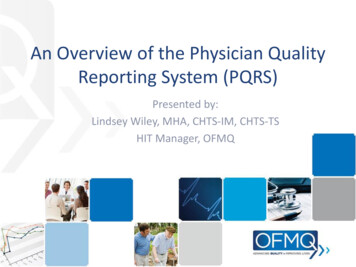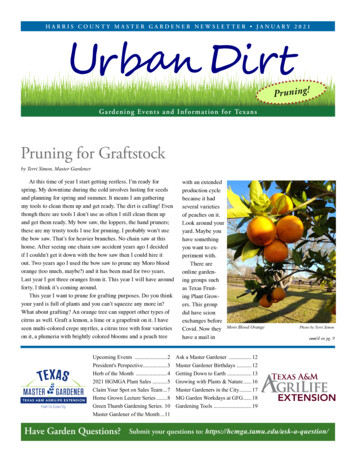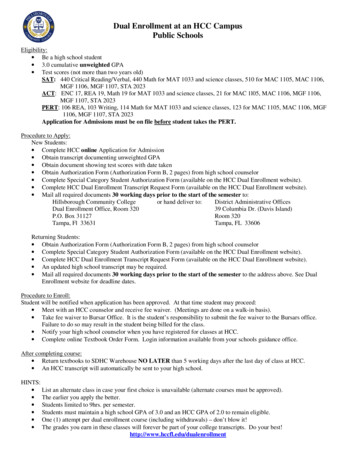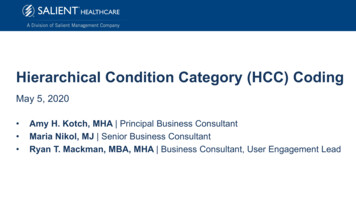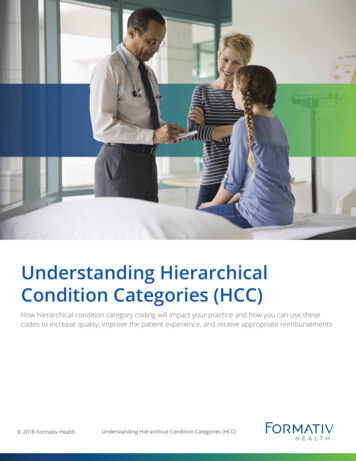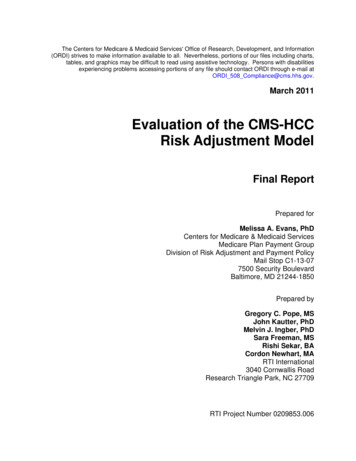
Transcription
The Centers for Medicare & Medicaid Services' Office of Research, Development, and Information(ORDI) strives to make information available to all. Nevertheless, portions of our files including charts,tables, and graphics may be difficult to read using assistive technology. Persons with disabilitiesexperiencing problems accessing portions of any file should contact ORDI through e-mail atORDI 508 Compliance@cms.hhs.gov.March 2011Evaluation of the CMS-HCCRisk Adjustment ModelFinal ReportPrepared forMelissa A. Evans, PhDCenters for Medicare & Medicaid ServicesMedicare Plan Payment GroupDivision of Risk Adjustment and Payment PolicyMail Stop C1-13-077500 Security BoulevardBaltimore, MD 21244-1850Prepared byGregory C. Pope, MSJohn Kautter, PhDMelvin J. Ingber, PhDSara Freeman, MSRishi Sekar, BACordon Newhart, MARTI International3040 Cornwallis RoadResearch Triangle Park, NC 27709RTI Project Number 0209853.006
Evaluation of the CMS-HCCRisk Adjustment ModelAuthors: Gregory C. Pope, MSJohn Kautter, PhDMelvin J. Ingber, PhDSara Freeman, MSRishi Sekar, BACordon Newhart, MAFederal Project Officer: Melissa A. Evans, PhDRTI InternationalCMS Contract No. HHSM-500-2005-00029I TO 0006March 2011This project was funded by the Centers for Medicare & Medicaid Services under contract no.HHSM-500-2005-00029I. The statements contained in this report are solely those of the authorsand do not necessarily reflect the views or policies of the Centers for Medicare & MedicaidServices. RTI assumes responsibility for the accuracy and completeness of the informationcontained in this report.RTI International is a trade name of Research Triangle Institute.
CONTENTSACRONYMS .1SECTION 1 ACA-MANDATED EVALUATION OF CMS-HCC MODEL.21.1 Introduction .2SECTION 2 PRIMER ON THE CMS-HCC MODEL .42.1 Health Insurance .42.2 Risk Adjustment .52.3 History of Risk Adjustment Models for Medicare Managed Care .62.4 Principles for Risk Adjustment Model Development .82.5 Elements and Organization of the CMS-HCC Model .102.5.1 Diagnostic Classification System .102.5.2 Hierarchies .112.5.3 CMS-HCCs .122.5.4 Clinical Vignette .132.6 CMS-HCC Model Versions .162.7 CMS-HCC Model Segments.162.7.1 Aged-Disabled Models — Community versus Institutional.162.7.2 Aged-Disabled Model for New Enrollees.172.7.3 End Stage Renal Disease (ESRD) Models.172.8 Adjustments to the CMS-HCC models .182.8.1 Frailty Adjustment .182.8.2 Chronic Condition Special Needs Plans with New Enrollees .192.9 Ongoing CMS-HCC Risk Adjustment Research .202.9.1 Profiling Beneficiary Groups Defined by Functional Impairments .212.9.2 Adding New Sources of Information .212.9.3 Model Specification .22SECTION 3 MODEL EVALUATION .243.1 CMS-HCC Model V12 Predictive Ratios .243.1.1 Aged-Disabled Community Continuing Enrollees .253.1.2 Institutionalized Continuing Enrollees .293.1.3 New Medicare Enrollees .313.2 Comparison of CMS-HCC Model V12 and V21.313.2.1 Percentage of Variation in Expenditures Explained (R2) .313.2.2 Predictive Ratios .32SECTION 4 MORTALITY RATE ANALYSIS FOR CHRONIC CONDITIONSPECIAL NEEDS PLANS .110iii
4.14.24.3Introduction .110Data .110Comparison of Actual and Expected Mortality Rates with Age/SexAdjustments .1114.3.1 Descriptive Results .1114.3.2 Age/Sex Adjustment Results .1114.4 Risk Adjustment Methodology .1124.5 Comparison of Actual and Expected Mortality Rates using Risk Adjustment.1124.6 Conclusions .113REFERENCES .118iv
TABLESTable 2-1Table 2-2Table 2-3Table 3-1Table 3-2Table 3-3Table 3-4Table 3-5Table 3-6Table 3-7Table 3-8Table 3-9Table 3-10Table 3-11Table 3-12Table 3-13Table 3-14Table 3-15Table 3-16Table 3-17Table 3-18Medicare Managed Care historic risk adjustment model R2 statistics .6Hypothetical example of CMS-HCC (version 12) expenditure predictions andrisk score community-residing, 76-year-old woman with AMI, angina pectoris,COPD, renal failure, chest pain, and ankle sprain .15Chronic conditions covered by special needs plans .20Predictive ratios for aged-disabled community continuing enrollees:Demographics .35Predictive ratios for aged-disabled community continuing enrollees: Decilesand percentiles of predicted 2005 annualized expenditures .36Predictive ratios for aged-disabled community continuing enrollees: Number ofpayment HCCs .37Predictive ratios for aged-disabled community continuing enrollees: HCCgroups.38Predictive ratios for aged-disabled community continuing enrollees: Two HCCgroups.39Predictive ratios for aged-disabled community continuing enrollees: ThreeHCC groups .41Predictive ratios for aged-disabled community continuing enrollees: Decilesand percentiles of predicted 2005 expenditures, diabetes .44Predictive ratios for aged-disabled community continuing enrollees: Decilesand percentiles of predicted 2005 expenditures, congestive heart failure .45Predictive ratios for aged-disabled community continuing enrollees: Decilesand percentiles of predicted 2005 expenditures, vascular disorders .46Predictive ratios for aged-disabled community continuing enrollees: Decilesand percentiles of predicted 2005 expenditures, chronic obstructive pulmonarydisease .47Predictive ratios for aged-disabled community continuing enrollees: Decilesand percentiles of predicted 2005 expenditures, cancer .48Predictive ratios for aged-disabled community continuing enrollees: Decilesand percentiles of predicted 2005 expenditures, heart arrhythmias .49Predictive ratios for aged-disabled community continuing enrollees: Prior yearhospital discharges .50Chronic condition special needs plans (C-SNPs) validation group definitions(Version 12 CMS-HCC model) .51Predictive ratios for C-SNP conditions for 2004-2005 aged-disabledcommunity continuing enrollees: Consolidated SNP groups version 12 on2004/2005 data .52Predictive ratios for C-SNP conditions for aged-disabled communitycontinuing enrollees: Deciles and percentiles of predicted expenditures version12 on 2004/2005 data .53Predictive ratios for institutionalized continuing enrollees: Deciles andpercentiles of predicted 2005 annualized expenditures .60Predictive ratios for institutionalized continuing enrollees: Number of paymentHCCs .61v
Table 3-19 Predictive Ratios for Institutionalized Continuing Enrollees: HCC Groups .62Table 3-20 Predictive ratios for aged-disabled new enrollees: Demographics, true newenrollee subsample .63Table 3-21 Predictive Ratios for Aged-Disabled New Enrollees: Deciles and Percentiles ofpredicted 2005 annualized expenditures, True New Enrollee Subsample .64Table 3-22 CMS-HCC model R2 statistics: Version 21 HCCs estimated on 2006-2007 dataversus version 12 HCCs estimated on 2004-2005 data .65Table 3-23 Predictive ratios for aged-disabled community continuing enrollees:Demographics model comparison.66Table 3-24 Predictive ratios for aged-disabled community continuing enrollees: Decilesand percentiles of predicted annualized expenditures model comparison .67Table 3-25 Predictive ratios for aged-disabled community continuing enrollees: Number ofpayment HCCs model comparison .68Table 3-26 Predictive ratios for aged-disabled community continuing enrollees: HCCgroups model comparison .69Table 3-27 Predictive ratios for aged-disabled community continuing enrollees: Decilesand percentiles of predicted expenditures, diabetes model comparison .70Table 3-28 Predictive ratios for aged-disabled community continuing Enrollees: Decilesand percentiles of predicted expenditures, congestive heart failure modelcomparison .71Table 3-29 Predictive ratios for aged-disabled community continuing Enrollees: Decilesand percentiles of predicted expenditures, vascular disorders model comparison .72Table 3-30 Predictive ratios for aged-disabled community continuing Enrollees: Decilesand percentiles of predicted expenditures, chronic obstructive pulmonarydisease model comparison .73Table 3-31 Predictive ratios for aged-disabled community continuing Enrollees: Decilesand percentiles of predicted expenditures, cancer model comparison .74Table 3-32 Predictive ratios for aged-disabled community continuing Enrollees: Decilesand percentiles of predicted expenditures, heart arrhythmias model comparison .75Table 3-33 Predictive ratios for aged-disabled community continuing enrollees: Prior yearhospital Discharges model comparison .76Table 3-34 Validation group definitions for body systems/disease group HCC categories:Version 12 CMS-HCC payment model and clinically-revised version 21 CMSHCC payment model.77Table 3-35 Predictive ratios for aged-disabled community continuing enrollees: Bodysystems/disease group HCC categories model comparison .84Table 3-36 Predictive ratios for aged-disabled community continuing enrollees: Deciles ofpredicted expenditures, body systems/disease group HCC categories .86Table 3-37 Chronic condition special needs plans (C-SNPs) validation group definitions(version 12 and version 21 CMS-HCC models) .99Table 3-38 Predictive ratios for C-SNP conditions for aged-disabled communitycontinuing enrollees model comparison .100Table 3-39 Predictive ratios for C-SNP conditions for aged-disabled communitycontinuing enrollees: Deciles and percentiles of predicted expenditures modelcomparison .102vi
Table 4-1Table 4-2Table 4-3Table 4-4Table 4-5Chronic condition special needs plans (C-SNPs) validation group definitions(V12) .113Comparison of C-SNPs and FFS enrollees mortality rates by age/sex categories .114Actual versus expected mortality rates for 2008 chronic condition SNPenrollees, using age/sex adjustments, by C-SNP type .115C-SNP enrollee expected mortality rate calculation for C-SNP type 11(HIV/AIDS)—matched by risk scores .116Actual versus expected mortality rates for 2008 chronic condition SNPenrollees, using risk score adjustment, by C-SNP type .117vii
FIGURESFigure 2-1Figure 2-2Figure 2-3Hierarchical Condition Categories aggregations of ICD-9-CM codes, version12 CMS-HCC model .10Hierarchical Condition Categories for coronary artery disease, created fromICD-9-CM ischemic heart diseases codes, version 12 CMS-HCC model.11Clinical vignette for CMS-HCC (version 12) classification communityresiding, 76-year-old woman with AMI, angina pectoris, COPD, renal failure,chest pain, and ankle sprain .14viii
ACRONYMSAAPCCadjusted average per capita costADLsactivities of daily livingAMIacute myocardial infarctionCADcoronary artery diseaseCCcondition categoryCHFcongestive heart failureCMSCenters for Medicare & Medicaid ServicesCOPDchronic obstructive pulmonary diseaseC-SNPchronic condition special needs plansCVDcerebrovascular diseaseDMEdurable medical equipmentDRGsdiagnosis-related groupsDXGdiagnostic groupESRDend stage renal diseaseFFSfee for serviceHCChierarchical condition categoryHOSHealth Outcomes SurveyICD-9-CMInternational Classification of Diseases, Ninth Revision, Clinical ModificationM CMedicare ChoiceMAMedicare AdvantageMMAMedicare Modernization Act of 2003PACEProgram of All-Inclusive Care for the ElderlyPIP-DCGPrincipal Inpatient Diagnostic Cost GroupSNPSpecial Needs Plan1
SECTION 1ACA-MANDATED EVALUATION OF CMS-HCC MODEL1.1IntroductionThe 2010 Patient Protection and Affordable Care Act (Public Law No: 111-148) includesseveral sections affecting the Medicare Program. Specifically, Sec. 3205 focuses on MedicareAdvantage (MA) plans for special needs individuals. Within that section of the legislation, “item(f) Risk Adjustment” contains revisions to the Social Security Act, including a new clause thatmandates 1) an evaluation of the Centers for Medicare & Medicaid Services (CMS) riskadjustment system used to account for medical expenditures and care coordination costs forspecified subsets of beneficiaries; and 2) a publication of that evaluation and any changesoccurring as a result of the evaluation:. (III) Evaluation.—For 2011 and periodically thereafter, the Secretary shallevaluate and revise the risk adjustment system under this subparagraph in orderto, as accurately as possible, account for higher medical and care coordinationcosts associated with frailty, individuals with multiple, comorbid chronicconditions, and individuals with a diagnosis of mental illness, and also to accountfor costs that may be associated with higher concentrations of beneficiaries withthose conditions. (IV) Publication of evaluation and revisions.—The Secretary shall publish, aspart of an announcement under subsection (b), a description of any evaluationconducted under subclause (III) during the preceding year and any revisions madeunder such subclause as a result of such evaluation.''The CMS hierarchical condition categories (CMS-HCC) model, implemented in 2004,adjusts Medicare capitation payments to Medicare Advantage health care plans for the healthexpenditure risk of their enrollees. Its intended use is to pay plans appropriately for theirexpected relative costs. For example, MA plans that disproportionately enroll the healthy arepaid less than they would have been if they had enrolled beneficiaries with the average riskprofile, while MA plans that care for the sickest patients are paid proportionately more than ifthey had enrolled beneficiaries with the average risk profile.Although this Affordable Care Act legislative mandate for an evaluation of the CMSHCC risk adjustment model is new, the evaluation process is well established. CMS conductscomprehensive evaluations of its CMS-HCC model on a regular basis, including evaluating themodel on the dimensions specified in the Affordable Care Act.This report is a record of the 2011 evaluation of the CMS-HCC model. It contains threemajor sections: a primer on the CMS-HCC model and more generally the use of risk adjustmentwithin a health insurance market; an evaluation of the CMS-HCC model, including an evaluationof the predictive accuracy of the CMS-HCC model for individuals and groups; and an analysis todetermine if there are integral differences between the individuals in MA Chronic Condition2
Special Needs Plans (C-SNPs) and fee-for-service (FFS) beneficiaries with similar diagnosticprofiles on whom the CMS-HCC model is calibrated.For information on how the risk adjustment model addresses frailty, please refer toSection 2, where extensive research on the frailty model and potential methods for moreeffectively capturing these costs are summarized. For information on how the risk adjustmentmodel performs in capturing the costs of individuals with multiple, comorbid chronic conditions,and individuals with a diagnosis of mental illness, please refer to Section 3 and the extensivediscussion of model performance over a wide range of diagnoses, combinations of diagnoses,and range of risk given a number of serious conditions. Finally, for discussion of an assessmentof the ability of the risk adjustment model to capture the scale of morbidity among beneficiariesenrolled in C-SNPs, please refer to Section 4.3
SECTION 2PRIMER ON THE CMS-HCC MODELIn this section we present an introduction and overview on the CMS-HCC riskadjustment system. Risk adjustment is a method of adjusting capitation payments to healthplans, either higher or lower, to account for the differences in expected health costs ofindividuals. Insurers determine their revenue needs based on a variety of factors, includingtrends in medical expenditures and anticipated enrollment, and determine how much to vary thepremium charged to individuals or small groups of enrollees using population characteristicssuch as age, smoking habits, and past history of illness. The risk adjustment models used in theMA program function as more comprehensive methods of underwriting in which diagnoses anddemographic information are used to set each enrollee’s monthly capitation rate. As with anyinsurance product, the system is intended to be accurate at the group level. At the individuallevel, predicted medical costs can be lower or higher than actual medical costs, but at the grouplevel, below-average predicted costs balance out above-average predicted costs. Below, we firstpresent relevant background on key characteristics of health insurance and then we describe themain components of the CMS-HCC models.2.1Health InsuranceIn general, insurance is a form of risk management primarily used to hedge against therisk of a contingent, uncertain loss. Insurance can be defined as the equitable transfer of the riskof a loss, from one entity to another, in exchange for payment. Health insurance is an agreementbetween an organization and an individual to provide or pay for at least part of the costs ofmedical services for the individual and to protect that person against the risk of high-costmedical care in the case of a serious accident or illness. Not everyone will experience high-costmedical events; but for those who do, the financial impact could be devastating.The concept of pooling risk is fundamental for all types of insurance because a large riskpool is needed to produce stable and measurable characteristics that can be used to accuratelyestimate future costs (AAA, 2006). Health insurance is designed to pool the financial risk of ahigh cost medical event across a large group of people. The majority of individuals in the riskpool pay more than their actual health services cost—they are willing to accept a small loss toguard against the risk of a major loss. The excess payments are pooled to cover the cost ofindividuals who do experience high-cost events.Medicare is one of the world’s largest health insurance programs, providing insurance toapproximately 47 million beneficiaries. About one-fourth of Medicare beneficiaries receive theirMedicare health benefits through private health care plans, a program known as MedicareAdvantage (MA). Medicare pays these participating health plans a monthly capitation rate toprovide health care services for their enrollees.Medicare beneficiaries vary greatly in terms of their health status, which in turn affectstheir utilization and costs. Those with serious illnesses, multiple chronic conditions, or who arefrail will require more care and will have higher medical costs than their healthier counterparts.If a MA health plan selected only the highest-cost beneficiaries (high risk), it would havedifficulty remaining viable with unadjusted capitation rates. In contrast, if it selected a healthierthan-average pool in its enrollment (low risk), it would make excess profits at the expense of the4
MA program if capitation rates were unadjusted. Risk selection can occur by chance or bypractices implemented by health plans (AARP, 2009). For example, if a health plan were to sethigh copayment rates for office visits to specialists, beneficiaries needing care from specialistsmight select not to enroll in that plan. To address this issue of risk selection and accuratelycompensate MA health plans for accepting the risk of enrolling beneficiaries of varying healthstatuses, the MA program uses risk adjustment and administrative policies. 12.2Risk AdjustmentThe Medicare risk adjustment models use data from a large pool of beneficiaries (fullsample sizes over 1 million for the CMS-HCC models) to estimate predicted costs on average foreach of the component factors (e.g., age-sex, low income status, individual disease groups). Thismethod of risk assessment is in accordance with the Actuarial Standard Board’s ActuarialStandard of Practice for risk classification—the risk characteristics are related to expectedoutcomes and the risk classes are large enough to allow credible statistical inferences (ASB,2005). The predicted costs from the risk adjustment models are then converted to relative riskfactors so that payment adjustments can be made relative to the average Medicare beneficiary. Itis important to understand that the underlying risk assessment is designed to accurately explainthe variation at the group level, not at the individual level, because risk adjustment is applied tolarge groups (AAA, 2010). As the American Academy of Actuaries notes:“. Determining average experience for a particular class of risk is not the sameas predicting the experience for an individual risk in the class. It is bothimpossible and unnecessary to predict expenditures for individual risks. If theoccurrence, timing, and magnitude of an event were known in advance, therewould be no economic uncertainty and therefore no reason for insurance.” (AAA,1980)By risk adjusting the payments to MA plans—beneficiaries with lower-than-averagepredicted costs have their payments decreased incrementally based on their risk profile andbeneficiaries with higher-than-average predicted costs have their payments increasedincrementally based on their risk profile—CMS reduces the incentives for these plans to riskselect only the healthiest beneficiaries and avoids indirectly penalizing plans that provide carefor the most seriously ill beneficiaries.The suitability of a risk adjuster depends on the nature of the groups to be paid using theadjuster. The MA program now allows not only general population health plans to participate,but specialty plans as well, in particular plans enrolling beneficiaries with a specified subset ofchronic diseases. Sections 2.3 to 2.8 describe that characteristics and ability of the CMS-HCCrisk adjustment model to account for the costs of these conditions as well as the comorbidities1Risk adjustment is one of a set of techniques CMS implements to compensate MA plans and to protectbeneficiary access to these plans. Other techniques include these: a Total Beneficiary Cost metric, whichbeginning in CY2011 evaluates changes from year to year in a plan’s cost-sharing or benefits and denies bidsthat propose significant increases in cost-sharing or decreases in benefits; and Discriminatory Cost-SharingAssessments, which beginning in CY2012 provide three benefit discrimination assessments—Per Member PerMonth Actuarially Equivalent Cost Sharing Maximums, Service Category Cost Sharing Standards, andDiscriminatory Pattern Analysis. (Advance Notice, CY2012)5
and complications related to these conditions. The evaluation of its ability to predict risk forenrollee groups that have concentrations with particular medical conditions, as well as otheratypical profiles, are in Section 3.2.3History of Risk Adjustment Models for Medicare Managed CareCMS has developed its risk adjustment methodology over time, modifying it to betteraccount for differences in expected health expenditures. Table 2-1 presents a summary of theMedicare managed care risk adjustment models and their explanatory power as measured by R2.It is followed by a description of each of the models.Table 2-1Medicare Managed Care historic risk adjustment model R2 statistics1PaymentyearsRisk adjustment modelR2Adjusted Average Per Capita Cost CC2,42004-20080.0997Version 12 CMS-HCC (2005 recalibration)3,42009-current0.1091Version 21 CMS-HCC (2007 recalibration; 2009 clinical revision)3,4proposed0.1246NOTES:1.The R2 statistic refers to the percentage of variation in individual expenditures predicted.2.The R2 statistics for the three earliest models are based on the 1999-2000 calibration samplewhich included both community and institutional beneficiaries.3.These models are estimated on the recalibration samples and include community continuingenrollees only, no months of institutional status are included.4.The CMS-HCC models include payment model HCCs only.SOURCE: RTI analysis of Medicare claims and enrollment data—1999-2000, 2004-2005, and2006-2007 5% sample.Historically, capitation payments to Medicare managed care plans were linked to FFSexpenditures by geographic area, with payments set at 95 perc
COPD chronic obstructive pulmonary disease . C-SNP chronic condition special needs plans . CVD cerebrovascular disease . DME durable medical equipment . DRGs diagnosis-related groups . DXG diagnostic group . ESRD end stage renal disease . FF



